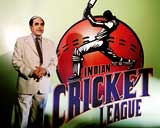Wake up and smell the opportunity
The ICL may just be a blessing in disguise for the BCCI. Pity they don't seem to be able to recognise it
27-Jul-2007
|
|

|
The chatter is louder than Matt Prior in full flow: Brian Lara is on board, Shane Warne has expressed his desire to jump on and is that Glenn McGrath in the distance? There's a possibility that these three, and other stars, will play Twenty20 cricket - itself a novelty - in India as part of the Indian Cricket League (ICL). Though all three have retired from international cricket, Warne is active on the county circuit, Lara looks to have gas in his tank still, and anyone who saw McGrath bowl in his last international match, the World Cup final, would find it hard to believe that he has reached pensionable age.
That's only half the story; the other half is the ICL's running battle with the Board for Control of Cricket in India, aka the Bureaucratic Custodians of Cricket in self-Interest. The BCCI has rejected the idea of the ICL and has asked everyone it has control over - which is pretty much the entire cricket establishment, home and away - to steer clear. Or else.
The board's proprietary stand over cricket in India is, at the very least, at odds with ground realities. The farcical way it runs the national team is well known; less documented, though perhaps more damaging, is how it runs all other levels of cricket in the country. And all other aspects, from umpires to ground scheduling.
The board's objection has little to do with the ICL being a privately run league. There are hundreds of those in India; among the most famous are Mumbai's Times League and Kanga League, which have coexisted with the official system for years, functioning as finishing schools for some of Mumbai's best players, and hugely benefiting Indian cricket. The key difference between those and the ICL is this: the ICL involves television programming, and so treads directly on the BCCI's turf. All else flows from there.
The ICL will be based on the Twenty20 game, the least developed of cricket's three formats in India. The first edition of the BCCI's own Twenty20 tournament sank without a trace, shunted to the end of the domestic calendar last season, when it was in direct competition to the World Cup in the Caribbean. Few recall who won, fewer still care. Least of all, apparently, the BCCI itself: India's provisional squad for the Twenty20 World Championship in South Africa later this year has precisely three representatives from the two domestic finalist teams. That's three among 30 players, and it's anyone's guess if any will make the final cut.
|
|
The BCCI has never been hot on nurturing a system; the rise of one-day cricket in India - even the World Cup victory 24 years ago - has been more by accident than design. By embracing the ICL, the board can feed off a system that is already in place and is effectively someone else's headache. This way, it can focus on its core competence - making money.
Over in the West Indies, the umbrella cricket board has, after a year's resistance, bought into Allen Stanford's vision for cricket in the region. Last year the West Indies Cricket Board (WICB) stymied the grand finale of the Stanford 20/20 tournament, an all-stars game between the best of the West Indians and a South African side for a $5million purse. Stanford bit his lip and tried again, and the upshot is that the next season has the WICB on board, Cricket Australia and Cricket South Africa interested, and the ICC worried.
The ICL's biggest problem currently is the lack of a venue, with the BCCI leaning heavily on those who own stadiums, at home or abroad, to close all doors to the rebels or risk losing India matches. But the ICL can well flex its own muscles and simply make the down payment on a ten-year lease. Money is not the problem now, and the suits at the BCCI are amateurs against the industrial strength of the Zee group, the ICL's backers.
|
|

|
Zee can learn from Stanford here. If the BCCI continues to hold out and play the neighbourhood bully, the ICL, which has already tied up with a leading infrastructure development company, could simply build its own workspace. Stanford's complex, near the airport in Antigua, includes a cricket ground, banks, restaurants, a health club with swimming pool, gym, and aerobics studios; a hotel and conference centre are in the works.
In fact, there is a precedent closer home, in the form of the Sahara group, which has built a plush mini-city in the forbidding rocky hills near Pune in western India, and then attracted a host of big names in sport - Daley Thompson, Anna Kournikova, Boris Becker, Nadia Comaneci and Edwin Moses among them - as brand ambassadors.
Other problems, including hiring players, can be dealt with similarly. The BCCI could yet be hoist by its own petard: its failure to invest in a cricketing culture, and the resulting lack of viable opportunities for former cricketers, could make any option seem attractive. The carrot of a pension when they eventually retire - approximately Rs 35,000 a month - will not mean as much to a Ganguly or a Laxman as the chance of playing with some big names.
That it should come down to this zero-sum game is a pity. Indian cricket is big enough for two players, or 20, or 200, and it would help if they were pulling in the same direction. Instead of cutting its nose off to spite its face, the BCCI should wake up and smell the coffee - and the opportunity.
Can the ICL and the BCCI co-exist in Indian cricket? Tell us here
Jayaditya Gupta is executive editor of Cricinfo in India